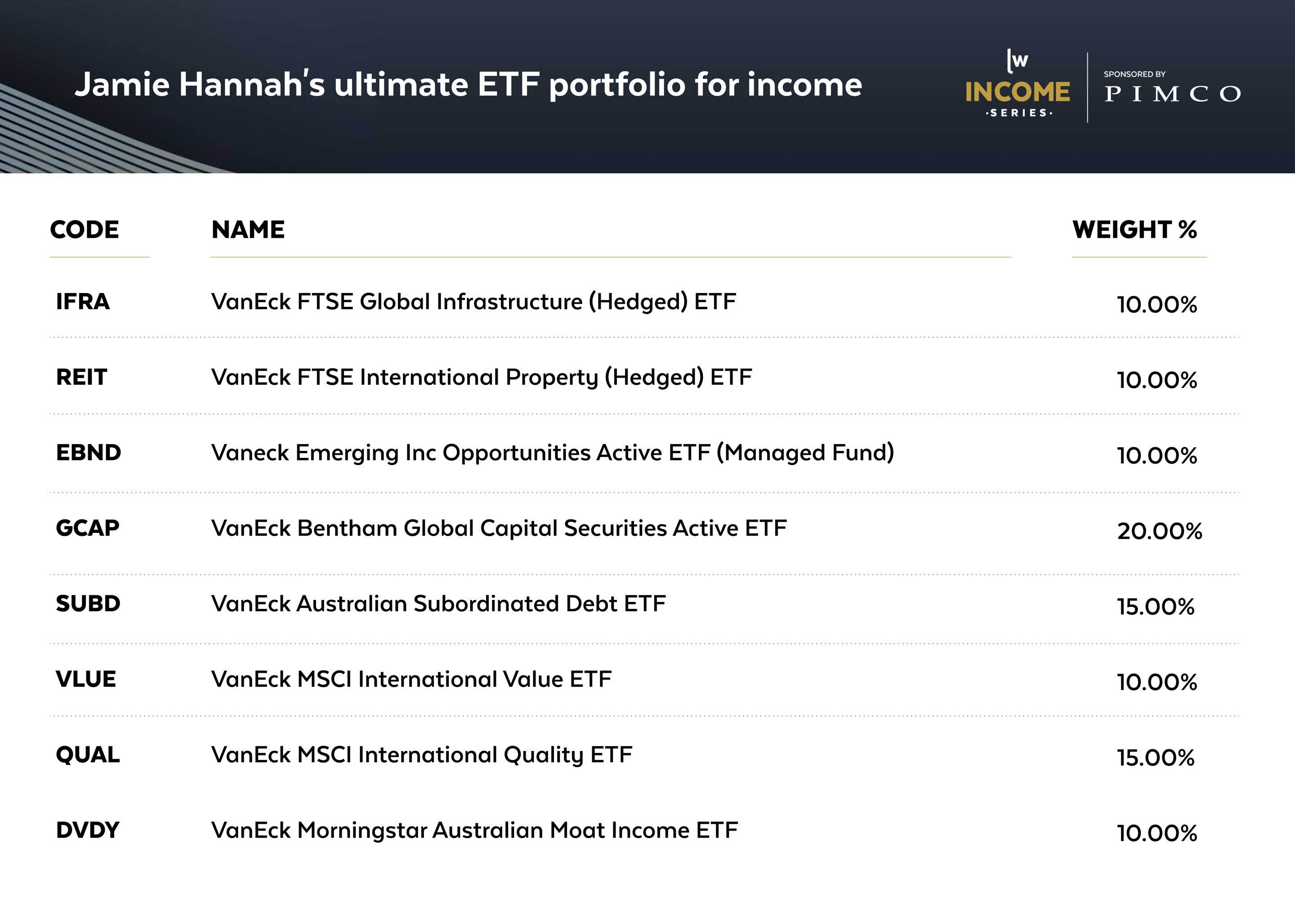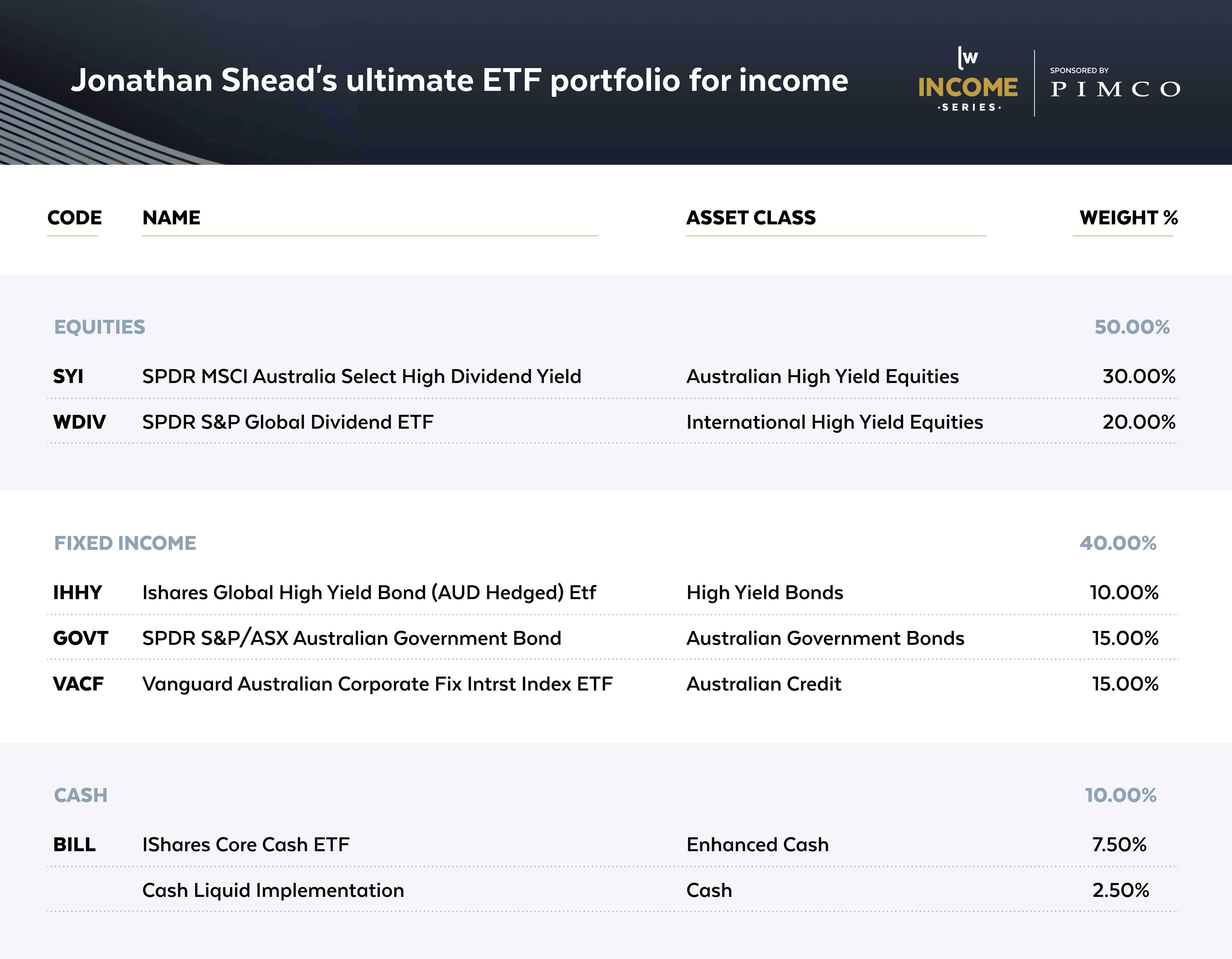2 provider-approved ETF portfolios for sustainable returns and income
Exchange-traded funds are diversified, liquid, cheap and transparent, says VanEck Australia's deputy head of investments and capital markets, Jamie Hannah, making them a "highly efficient" vehicle for accessing income.
Similarly, State Street Global Advisor's Australia head of investments, Jonathan Shead, believes that ETFs are a great option for income investors, arguing them to be the "perfect balance of income and risk".
They are particularly useful to investors in the current low cash rate environment as they allow investors to earn more income after fees (thanks to their lower costs) compared to other investment options, like managed funds or LICs, he adds.
So, in this wire, you'll find not one but two ultimate portfolios for income from these two ETF providers. These include ETFs with exposures to equity, property, high yield bonds, infrastructure and credit.
Plus, we also discuss continued fee compression across the industry, the active versus passive debate when it comes to income, as well as differing views on whether size (funds under management) actually matters for ETFs.
Note: The interview with State Street took place on September 22nd, 2021. The interview with VanEck took place on September 27th, 2021. The portfolios in this article are of a general nature, and should not be taken as personal advice. Please talk to a financial adviser or expert before making any investment decisions.
The risks and rewards of investing in ETFs for income
The rewards of investing in ETFs for income mirror those when investing in ETFs generally, including share-like liquidity, diversification, and transparency into holdings, all wrapped into a cost-efficient vehicle.
"From that perspective, you are getting access to the income, but you are also getting access to a highly efficient kind of vehicle in which to do it," Hannah says.
Shead agrees, arguing the wide range of ETFs available on the ASX (and Chi-X) means that "investors working with a financial adviser can find a perfect balance of income and risk".
"The income you earn is after the fees that you pay, so the fact that ETFs are low cost makes them well-suited for income-focused investors," he adds.
However, just like all investments, ETFs do not come without risk.
"There is a risk. A risk with an ETF is that you can lose capital. Like any investment, yes, you can get some income, but the higher up the risk curve you go, the more income you might get, but the more risk you would wear," Hannah says.
Aside from this risk, Shead notes that income from ETFs is typically not fixed - which may be problematic for some investors.
"Because ETFs distribute the income that they receive, that income is not going to be the same quarter to quarter or even year to year," he says.
"So if, for example, an ETF holds underlying company securities, then if dividends go up or down, the ETF's income will go up or down. Or if the ETF receives more income in one quarter than another quarter, those payments may not be stable, perhaps more significantly because the price of an ETF on the exchange will move according to its underlying investments."
He also highlights that investors are often unaware that an ETF's price on an exchange will drop immediately after it pays a distribution.
"If it's trading at $25 on the exchange and it pays an income of $0.25 per unit, then you would expect it to start trading at $24.75," Shead explains.
"So that's something else that investors quite often miss when they're looking at ETFs for income."
Does size matter?
Our providers have differing views on funds under management, with Shead revealing that yes, size does matter, but not in the way you would think.
"I think of size through three different lenses," he says.
"The first lens would be from a portfolio point of view. Now an ETF doesn't have to be particularly large to track its index. And so, in most cases, you don't need a huge ETF to successfully track an index and to generate income for investors."
From a commercial point of view, it is obviously ideal for an issuer to run a larger ETF as it can generate more fees from investors (and revenue for the issuer). However, Shead notes that it can also make it easier for issuers to provide lower fees in these ETFs.
"Where size comes into play is probably the third area, which is in trading for investors," he says.
"When you're looking at the cost of an ETF, you need to look at the total cost of ownership. So that's not only the management fee but what it costs you to trade that ETF on the exchange."
These costs include brokerage but also spread (the gap between the bid price and the offer price of an ETF).
"Now the very largest ETFs, like STW, because they're so heavily traded and so widely owned, that spread between the bid price and the offer price is often much tighter and they're cheaper to trade than smaller ETFs," Shead explains.
"So I would say trading for the very largest ETFs is where they have the most significant advantage. Of course, if you're a long-term buy and hold investor, that's going to be a less significant issue. But if you're trading ETFs often, that's going to be a more significant issue."
Meantime, Hannah doesn't believe that size matters with ETFs, arguing instead that it is the manager's track record that is generally more important.
"Size doesn't matter because onscreen, we have market makers. And market makers put quotes on the buy and the sell-side of the ASX, so you're always able to buy and sell an ETF at close to fair value," he explains.
"Unlike other instruments like LICs, an ETF's holdings are transparent, so the market maker is able to price it at fair value."
Active versus passive ETFs
Shead believes the issue is less about passive versus active, and more about "transparent versus opaque".
"Truth be told, almost all income-focused products are, in a sense, active," he says.
"I think the only truly passive products are market cap index products. In other words, products that buy virtually every security in the market and hold it at its market cap weight. If a product is not buying every security in the market at its market cap weight, it is in a sense not really passive."
SSGA offers equity ETFs (for income) like the SPDR MSCI Australia Select High Dividend Yield ETF (ASX: SYI) and the SPDR S&P Global Dividend ETF (ASX: WDIV), which both follow clear index-tracking rules. It also offers other ETFs that are not "income-focused" per se but still produce yield for investors, such as the SPDR S&P/ASX 50 ETF (ASX: SFY) and the SPDR Dow Jones Global Real Estate ETF (ASX: DJRE).
"We publish the holdings of SYI and WDIV every day. So for investors who want higher-yielding equity securities, there's a very high level of transparency," Shead says.
"It is in a sense active because it's not owning every company in the market, but it's highly transparent."
The level of transparency is typically unheard of in non-index tracking active products, regardless of whether they are traditional managed funds or ETFs, he adds.
Of VanEck's 29 ETFs, nine are focused on producing passive income streams for investors, and cover everything from fixed income to global equities (as well as funds with active management and those tracking an index).
"We produce a lot of passive index-tracking ETFs, and they offer good returns, and we're generally focused on that on the equity side," Hannah says.
However, when it comes to fixed income ETFs, particularly those invested in areas like emerging market debt, he believes that active management is key.
"It requires a different skill set. So with that particular space, we believe that you're getting a better return if you're going with active management," he says.
"However, the fact is both of them have benefits, and both of them have cons, I should say, as well. That said, it's all about cost, and index tracking has generally been a lower-cost investment vehicle."
So why would you want to invest in an actively managed ETF over an unlisted managed fund?
Well, Hannah says that you have greater transparency over the buy and sell price of the ETF, plus, when selling, you will be able to get your money in your pocket far quicker than you would with a managed fund.
"The settlement period for the ASX is T plus two. With an unlisted fund, you will complete a form. You'll send it off to the manager. They will then go about selling down the position to generate the money for you, but that might not be on the day," he says.
"You won't know the exact price immediately. It will take some time, and then it might take up to two weeks to get your money. So from that perspective, the ETF that's listed is considerably more transparent. It's more liquid, and you have more certainty about the whole entire process."
Expect further fee compression
Hannah believes investors can expect fee compression across new thematics and actively managed ETFs over the coming years.
"Fees will come down. As funds become more successful and more people invest in those asset classes or in these new thematics, there will be fee compression," he says.
"At the moment it's really the new managers putting themselves out there to try to see if these new thematics will catch on."
"Every ETF issuer is looking hard at what the needs of their customers are and they're looking to improve their ETF offerings and the ability of ETFs to meet investor needs," Shead adds.
"As the great investment democratizer, ETFs, I think, will continue to offer really transparent and low-cost ways of exposing asset markets."
Jamie Hannah's ultimate ETF portfolio for income
Hannah believes there are three types of ETFs that are essential to investors wanting to produce passive income streams; infrastructure, emerging market bonds, and global real estate.
His number one pick is the VanEck FTSE Global Infrastructure ETF (ASX: IFRA), which is currently yielding around 2.76% per annum but has plenty of tailwinds in its favour.
"One of the key things with infrastructure at the moment is that COVID-19 has really accelerated the development of governments putting money in to rebuild economies. And a lot of that money is going into infrastructure," he says.
"If we look at the US, they're doing a trillion-dollar-plus infrastructure bill right now. And in Europe, they've got the next generation fund."
Similarly, China, Australia and "every major economy in the world" is siphoning funds into infrastructure, he says.
"All of the existing infrastructure companies are absolutely best placed to win new contracts, to be getting new business through the door and having new areas of revenue growth," Hannah says.
"Infrastructure is where the best benefits are going to be, and it pays a good yield."

Hannah also points to emerging market bonds as a great source of income, albeit an area which investors would typically avoid.
"Buying an emerging market bond is generally not even thought about by a lot of asset managers, let alone mums and dads," he says.
"It does increase the risk profile by investing in some of these countries, but you're also increasing the return you're getting on your income."
Bonds are rated above equities if there was any default, Hannah explains. So in the case of a default, a bondholder is more likely to still get their income than an equity shareholder.
"The same holds true when you're in emerging markets. And a lot of these are government-issued too," he says.
In addition, emerging market bonds can work counter-cyclically to developed markets, Hannah adds.
"And it's paying an attractive yield to entice people to come in and buy these types of bonds," he says.
"So EBND offers an investor something completely different with a good yield."
Hannah is also a big fan of global property exposure for income and points to the firm's International Property ETF (ASX: REIT) as a great option, which he believes can provide investors with both diversification and yield. The ETF holds around 300 global REITs across 22 different countries.
"Many Australians just buy Australian REITs, AREITs or the old property trust. Yes, they do have a very good income yield in Australia, but you're only tied to these Australian real estate assets," he says.
"So what it's doing is it's offering you a global coverage across real estate countries from the US and Canada and Europe and Asia."
"I think global REITs definitely should make up a core part of any portfolio, not just the Australian REITs."
Jonathan Shead's ultimate ETF portfolio for income
Shead notes that it is important for investors to speak to a financial adviser or professional to make sure they have the right balance between income and risk in their portfolios.
However, generally, he believes a "roughly equal balance" between equity-orientated income-generating assets and stable, lower-yielding assets like government bonds, investment-grade credit, high yield credit, and even cash, is key.
"The key here is diversity. So that's diversity between asset classes, but also making sure that any ETFs you do include are well-diversified in their holdings underneath," he says.

Why you can’t miss the Livewire Income Series
Livewire’s 2021 Income Series gives investors best in class education and premium content to build a bulletproof income portfolio.
Click here to view the dedicated website, which includes:
- A list of income-focused ETFs, LICs and funds.
- Detailed fund profile pages, with data powered by Morningstar.
- Exclusive interviews with leading fund managers.
- Videos and articles to help you perfect your income strategy.
Want more content like this?
Give this wire a like if you've enjoyed the discussion and hit follow to be notified when new episodes are released.
If you're not an existing Livewire subscriber you can sign up to get free access to investment ideas and strategies from Australia's leading investors.
2 topics
9 stocks mentioned
1 contributor mentioned


